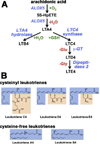Mammalian lipoxygenases and their biological relevance
- PMID: 25316652
- PMCID: PMC4370320
- DOI: 10.1016/j.bbalip.2014.10.002
Mammalian lipoxygenases and their biological relevance
Abstract
Lipoxygenases (LOXs) form a heterogeneous class of lipid peroxidizing enzymes, which have been implicated not only in cell proliferation and differentiation but also in the pathogenesis of various diseases with major public health relevance. As other fatty acid dioxygenases LOXs oxidize polyunsaturated fatty acids to their corresponding hydroperoxy derivatives, which are further transformed to bioactive lipid mediators (eicosanoids and related substances). On the other hand, lipoxygenases are key players in the regulation of the cellular redox homeostasis, which is an important element in gene expression regulation. Although the first mammalian lipoxygenases were discovered 40 years ago and although the enzymes have been well characterized with respect to their structural and functional properties the biological roles of the different lipoxygenase isoforms are not completely understood. This review is aimed at summarizing the current knowledge on the physiological roles of different mammalian LOX-isoforms and their patho-physiological function in inflammatory, metabolic, hyperproliferative, neurodegenerative and infectious disorders. This article is part of a Special Issue entitled "Oxygenated metabolism of PUFA: analysis and biological relevance".
Keywords: Atherosclerosis; Cancer; Eicosanoid; Infection; Inflammation; Stroke.
Copyright © 2014 Elsevier B.V. All rights reserved.
Figures







References
-
- Ivanov I, Heydeck D, Hofheinz K, Roffeis J, O'Donnell VB, Kuhn H, Walther M. Molecular enzymology of lipoxygenases. Archives of biochemistry and biophysics. 2010;503:161–174. - PubMed
-
- Haeggstrom JZ, Funk CD. Lipoxygenase and leukotriene pathways: biochemistry, biology, and roles in disease. Chemical reviews. 2011;111:5866–5898. - PubMed
-
- Mancini AD, Di Battista JA. The cardinal role of the phospholipase A(2)/cyclooxygenase-2/prostaglandin E synthase/prostaglandin E(2) (PCPP) axis in inflammostasis. Inflammation research : official journal of the European Histamine Research Society … [et al.] 2011;60:1083–1092. - PubMed
Publication types
MeSH terms
Substances
Grants and funding
LinkOut - more resources
Full Text Sources
Other Literature Sources
Research Materials

